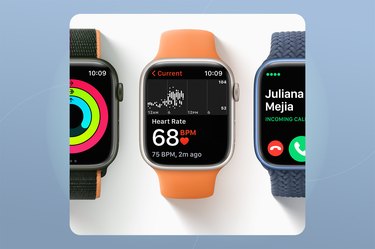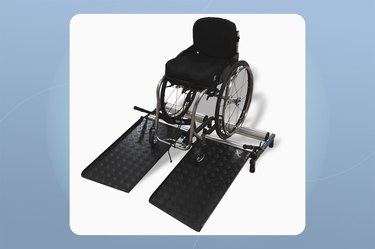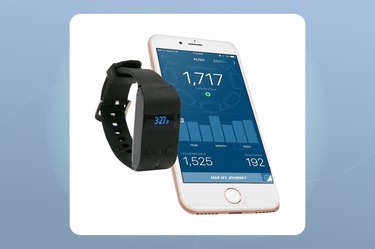Options are limited when it comes to wheelchair fitness trackers, but companies like Apple and Permobil are innovators in this area.
Credit: Elize Strydom / Moment / GettyImages
We’re not all Paralympians, but many wheelchair users like me can still benefit from cardio training.
The U.S. government’s physical activity guidelines for Americans recommend that all adults, with or without disabilities, receive a total of at least 150 minutes (that’s 2 1/2 hours) of aerobic exercise per week, plus at least two weekly strength training sessions.
But there is no direct consensus on what this physical activity looks like. While people who walk may want to take 10,000 steps a day, there is no such standard for people who use wheelchairs.
Experts say this is because government recommendations don’t often consider disabled people.[Editor’s note: LIVESTRONG.com typically uses person-first language such as “people with disabilities,” but we recognize different people prefer different terminology. At the request of the writer, we are using identity-first language here.]
Current recommendations fail to address multiple types of obstacles for disabled people, says Maureen Conner, PT, DPT, physical therapist and neurologist in the spinal cord injury rehabilitation program at Craig Hospital in Englewood, Colorado, including:
- Physical restrictions, such as restricted mobility or overload injuries
- Environmental restrictions, e.g. B. Difficulty accessing adaptive exercise equipment
- Psychosocial restrictions, such as limited availability of nursing staff or financial resources
In fact, there are very few published exercise guidelines for disabled people. One of them, an October 2017 report in Spinal Cord, suggests at least 20 minutes of moderate to vigorous aerobic exercise twice a week, as well as regular strength training. (This was specifically for people with spinal cord injuries, so it’s worth noting that these recommendations may not apply to people with other disabilities.)
But “moderate to vigorous aerobic exercise” is often determined by measuring things like heart rate. For moderate cardio exercise, your target heart rate would be between 64 and 76 percent of your maximum heart rate, according to the Centers for Disease Control and Prevention. For vigorous activity, aim for a target heart rate between 77 and 93 percent of your MHR, an estimate of the fastest rate that your heart can safely beat every minute during exercise, based on your age.
Heart rate can be a good indicator of fitness for some wheelchair users, but it may not be suitable for everyone. Some wheelchair users have underlying conditions that “can lead to cardiovascular dysfunction and dull or abnormal responses to exercise, making it difficult to monitor exercise intensity with heart rate measurements,” says Conner.
Instead, she recommends wheelchair users monitor exercise intensity using what is known as the Perceived Exertion Scale (RPE). As the name suggests, RPE involves assessing how hard you work.
There are many ways to rate your exertion, but an easy version is to imagine a scale from 1 (very light activity) to 10 (maximum exertion). Anywhere from 4 to 6 is considered moderate intensity, while 7 to 8 is vigorous, says Conner. “Since this scale is a little more subjective, it may take a little practice to get used to.”
top
Everyone – with or without a disability – is different. Always consult your doctor before starting any exercise program. People with certain medical conditions like Myalgic Encephalomyelitis / Chronic Fatigue Syndrome (ME / CFS) may not be able to exercise at all.
Your doctor or physical therapist can help you find activities that work for your body. You can also get ideas from members of online forums and support groups who share your condition (s).
Why fitness tracking is limited in a wheelchair
Objective data – like speed and distance traveled – can be more difficult to track. While ambulatory athletes can wear running watches or other fitness trackers, choices for wheelchair users in the market are limited.
Traditional fitness trackers use arm movements to calculate steps. But wheelchair tracking involves more variables. For example, wheelchair users vary their pushing styles depending on the terrain and speed. The type of chair also plays a role: a very heavy “hospital chair” in my aerodynamic titanium TiLite requires a lot more force to cover the same distance.
A wheelchair tracker would allow you to enter the type of chair you are using. Ideally, such a tracker contains a wheel sensor to take terrain and speed into account. But more data can overwhelm existing device algorithms and drain batteries quickly.
Such adjustments to existing fitness trackers take time and effort, says Dan Ding, PhD, who heads Human Engineering Research Laboratories in the Department of Rehabilitation Science and Technology at the University of Pittsburgh. And, because of the relatively small size of the rolling population compared to other customers in their base, consumer fitness companies don’t have much financial incentive to improve measurements for wheelchair users.
Dan’s lab builds wheelchair activity tracking algorithms and equipment for research, but she says companies aren’t really interested in partnering with their lab or using their research in their products. “As researchers, we don’t really have the ability to get it to market. We don’t really have the ability to compete with these companies.”
3 companies that make a difference
Here are some of the brands that have gone out of their way to develop and launch products that closely track wheelchair activity. Each type works slightly differently and offers different functions.

- Product:Apple Watch
- Traces:Outdoor wheelchair walking pace and outdoor wheelchair walking pace
- Costs:From $ 399
Apple conducted extensive testing into the development of its wheelchair tracking features in 2016, according to the original Computerworld report, and the company says they are constantly improving.
Apple Watch users can turn on the wheelchair setting in the Health section of the Apple Watch app to track bumps instead of steps. Your iPhone will then register “different types of bumps, speeds and terrain”, according to Apple.
Instead of a standing target, you’ll see a rolling target and two different exercise tracking options: walking pace in an outdoor wheelchair and running pace in an outdoor wheelchair, which correlate with leisurely spinning or a more heartbreaking workout.

As I continue to be mostly at home shelter because of my high risk of COVID-19 complications, I decided to purchase an Invictus Active wheelchair treadmill so that I can keep my activity and fitness levels high while I work out at home.
Invictus offers a “Smart Plus” model of their wheelchair treadmill that uses Wahoo’s Blue SC tracker that allows me to track my speed and distance traveled. (It also includes a Tikr Fit wristband for measuring your heart rate.)
Instead of measuring wheel bumps like other trackers, this setup instead measures the number of revolutions of the treadmill roller and then calculates the distance traveled. Because the device is based on the roll size rather than the wheel size, which can vary, it eliminates a data variable and provides more accurate distance measurements.
“If you own a scale and couldn’t trust the scale to be correct, you wouldn’t be using it,” Scott Smith, Invictus owner and wheelchair user, told LIVESTRONG.com. “It’s a similar thing. Without accurate data, people won’t use it.”

Permobil manufactures TiLite manual wheelchairs and the SmartDrive Power Assist, a lightweight motor for manual wheelchairs. I own a TiLite and use my SmartDrive a lot when I’ve been out for a while; It helps with fatigue and stress on the shoulders by reducing the force you have to push.
You can control the SmartDrive with a portable wrist called a PushTracker (otherwise you will have to push the wheelchair to start the motor). The wearable syncs with the PushTracker app, which tracks the push of the wheelchair, daily distance traveled, and travel time (or the time between bumps), says Curtis Merring, occupational therapist and director of portfolio marketing at Permobil.
The newer smartwatch model PushTracker E2 provides more accurate data and can send you personal record notifications. It can also schedule practical reminders to maintain the wheelchair. Together with the app and SmartDrive, it serves the dual purpose of tracking activity and providing battery backup to reduce the strain on your upper body.
What do we do now?
Apple and Permobil say they are constantly improving their technology and upgrading their wearables. Invictus is working to create peloton-style virtual training courses. I look forward to joining them.
The ability to train at home gives disabled people independence and privacy. We don’t depend on a gym that may not provide us with the equipment or support we need. We don’t have to worry about being accepted by the fitness community there.
Also, many of us wheelchair users cannot go to the gym; for example, we might be house-bound or too high a medical risk. The ability to take streaming classes offers instant feedback and camaraderie. However, it remains to be seen when we will have access to the same benefits of tracking our activities as ambulatory exercisers.
Until then, there are a few things exercisers of all skill levels can do to improve accessibility with fitness tracking:
- Ask questions.Talk to people who work at your local fitness facilities and ask them what changes they are planning to make to suit a wide variety of athletes and when you can expect those changes.
- Contact brands.The more brands hear from customers asking about accessibility features, the more important it becomes to them that those features need to be prioritized.
- Support the brands that make change.As the saying goes, vote with your dollars. Buy products with accessibility even if you don’t use them, rather than products that aren’t as comprehensive.

